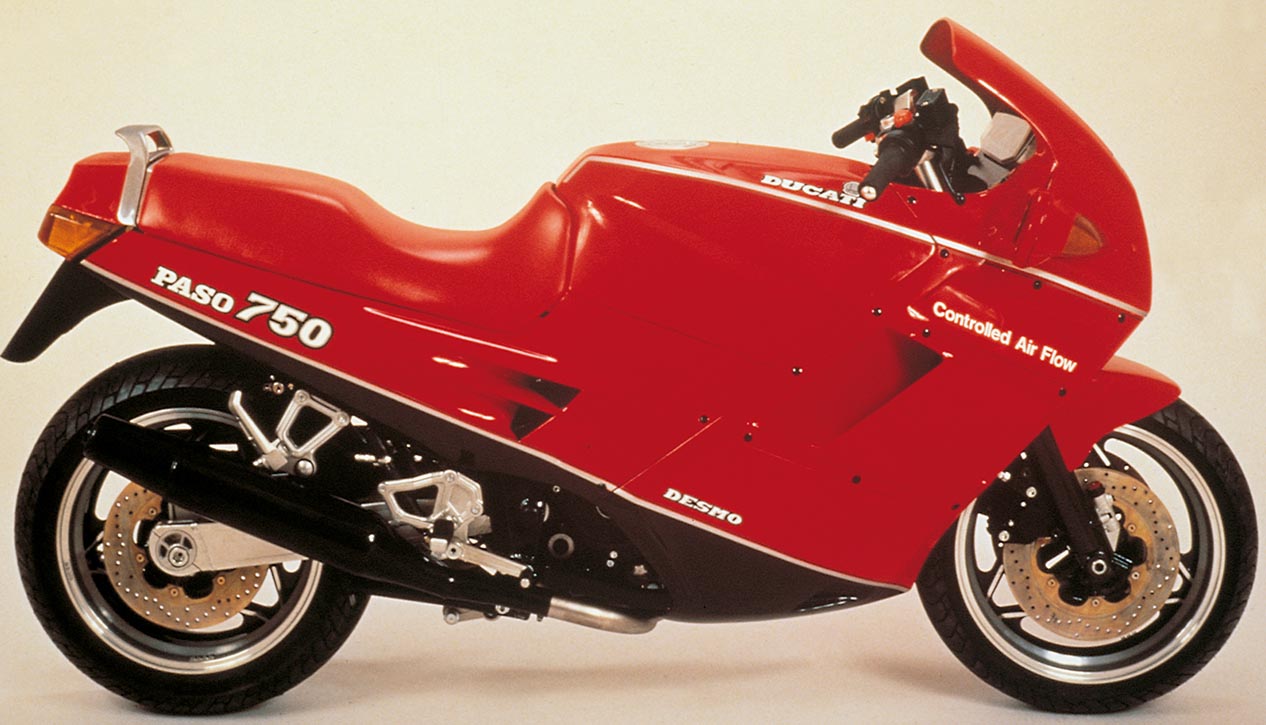Ducati has created many classic designs. From the 750SS of the 1970s, to the 916 of the 1990s, through the limited edition Desmosedici and even today’s V4 Panigales, but the Paso is an intriguing and often overlooked model, which provided a bridge between the ‘old’ and ‘new’ Ducatis in what was a tumultuous period for the company in the 1980s.
The Bologna company had been in state ownership for just over a decade from 1967 to 1978, when Italian engine manufacturer VM Motori took over for an ill-fated seven year spell.
In May 1985 the brand was purchased by Cagiva, which had been using Ducati’s V-twin engines in its own designs – such as the Elefant adventure bike and the half-faired Alazzura roadster.
Cagiva owners Claudio and Gianfranco Castiglione, set about reviving the range of models. This led to the 851 superbike, which in turn evolved into the world championship winning 888 and the iconic 916, but the Paso was one of the first fruits of the revived brand.
First shown at the Milan Motorcycle Show in November 1985, the Paso was penned by Massimo Tamburini. At the time, Tamburini was best known as the ‘Ta’ in Bimota, with whom he had had an acrimonious split, and he would later go on to style the iconic 916 and MV Agusta F4 (another brand owned by Cagiva).
The Paso was named after legendary racer Renzo Pasolini, the Italian superstar who had been killed along with Jarno Saarinen in a horrific pileup at the 1973 Italian Grand Prix. Ironically, it owed a lot to Bimota’s DB1 which had been commissioned by Cagiva and went on sale in 1985 and utilised a revised 750cc version of Fabio Taglione’s famed ‘Pantah’ V-twin.
Like the Bimota, the production Paso was distinguished by its fairing. The aerodynamic enclosed ‘jelly mould’ bodywork was similar in style to the Honda CBR600F ‘Hurricane’ which appeared a few years later and the bike was more of a sports tourer than an out and out sportster.
The engine was modified from the unit in 750 F1 Sport. It remained air cooled and with two desmodromically operated valves per cylinder, but the rear cylinder was reversed, which allowed the intakes to be paired and fed by a single car style Weber twin-choke carburettor between the ‘V’ of the cylinders.
The wording on the fairing said ‘Controlled Air Flow’ which was Ducati’s way of saying that there were strategically placed oil coolers on each side of the engine which, combined with vents in the fairing, stopped the fully enclosed motor from overheating.
The Paso never really took off, at what was a challenging time for Ducati, and early models never did much to improve the company’s reputation for inconsistent reliability and build quality.
The Paso was reasonably well received by the media of the day thanks to a good chassis that featured Marzocchi front forks, Ohlins rear suspension and a period 16” front wheel. The 750 had a three-year run, before being replaced by the upgraded Paso 906. As the name suggested, it featured a bigger engine (although actually 904cc) which was more powerful (up from 72bhp to 88bhp). The 906 was also water cooled and had a six (rather than five) speed gearbox. The sometime troublesome carburettor remained though, leading to often lumpy running around town, but that too was addressed with a third generation bike, the 906 i.e., which appeared in 1991.
As the name suggested (i.e. standing for iniezione elettronica, or electronic [fuel] injection) the last in the line of Pasos dumped the carb for a Weber fuel injection system. Power jumped a few more horsepower, to 90bhp, and the bike’s low speed manners improved too. The flighty 16” front wheel was also replaced by a more common 17” item, but none of that did much to add to the Paso’s popularity.
For all it was a relative sales flop, the Paso was a headline grabbing model from a manufacturer which spent most of the 1980’s on the brink. Around 9000 Pasos were built between 1986 and 1992, when it quietly slipped out of the range, but its demise led the way to new models that would be the genesis of the Ducati we know today. In 1993 the Bologna company started production of the first Monster, a mass market model which continues in the range today, while the super sexy 916 was introduced in 1994, with its stunning looks and race track success helping to make Ducati one of the most desirable motorcycle brands in the world.
These days a usable Paso can be found on the second hand market for between £3,000 and £5,000. With its distinctive styling, it’s a model that really stands out and a cheap way into the world of Ducatisti. And as the legendary Tamburini’s first Ducati, it’s surely a machine that can only gain in credibility in years to come.



